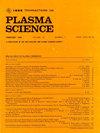膨胀等离子体射流中的静电探针测量
IF 1.3
4区 物理与天体物理
Q3 PHYSICS, FLUIDS & PLASMAS
引用次数: 0
摘要
建立了一种静电探针测量方法来测量膨胀等离子体射流中的电子温度、离子温度和电子密度。由于等离子体处于过渡流体力学状态,无碰撞理论和碰撞探针理论都不能直接应用于本案例。因此,采用了一种反演方法,在给定的等离子体条件下,迭代计算探针的电流-电压曲线形状,并直接与测量结果进行比较。使用这种方法,即使已建立的Langmuir探针理论不适用,也可以估计出温度和密度。本文章由计算机程序翻译,如有差异,请以英文原文为准。
Electrostatic Probe Measurements in an Expanding Plasma Jet
An electrostatic probe measurement has been established to measure the electron temperature, ion temperature, and electron density within an expanding plasma jet. Due to the plasma being in a transitional hydrodynamic regime, neither collisionless nor collisional probe theories could be directly applied to the present case. Therefore, an inverse method was used in which the shape of the current-voltage curve of the probe was iteratively calculated for given plasma conditions and directly compared with the measured result. Using this method, the temperatures and densities could be estimated even though the established Langmuir probe theory was not applicable.
求助全文
通过发布文献求助,成功后即可免费获取论文全文。
去求助
来源期刊

IEEE Transactions on Plasma Science
物理-物理:流体与等离子体
CiteScore
3.00
自引率
20.00%
发文量
538
审稿时长
3.8 months
期刊介绍:
The scope covers all aspects of the theory and application of plasma science. It includes the following areas: magnetohydrodynamics; thermionics and plasma diodes; basic plasma phenomena; gaseous electronics; microwave/plasma interaction; electron, ion, and plasma sources; space plasmas; intense electron and ion beams; laser-plasma interactions; plasma diagnostics; plasma chemistry and processing; solid-state plasmas; plasma heating; plasma for controlled fusion research; high energy density plasmas; industrial/commercial applications of plasma physics; plasma waves and instabilities; and high power microwave and submillimeter wave generation.
 求助内容:
求助内容: 应助结果提醒方式:
应助结果提醒方式:


